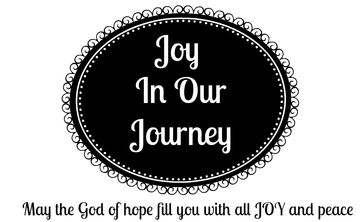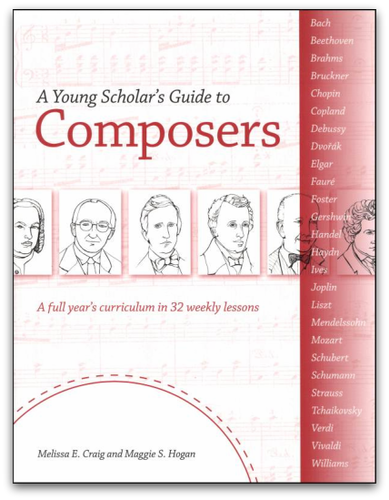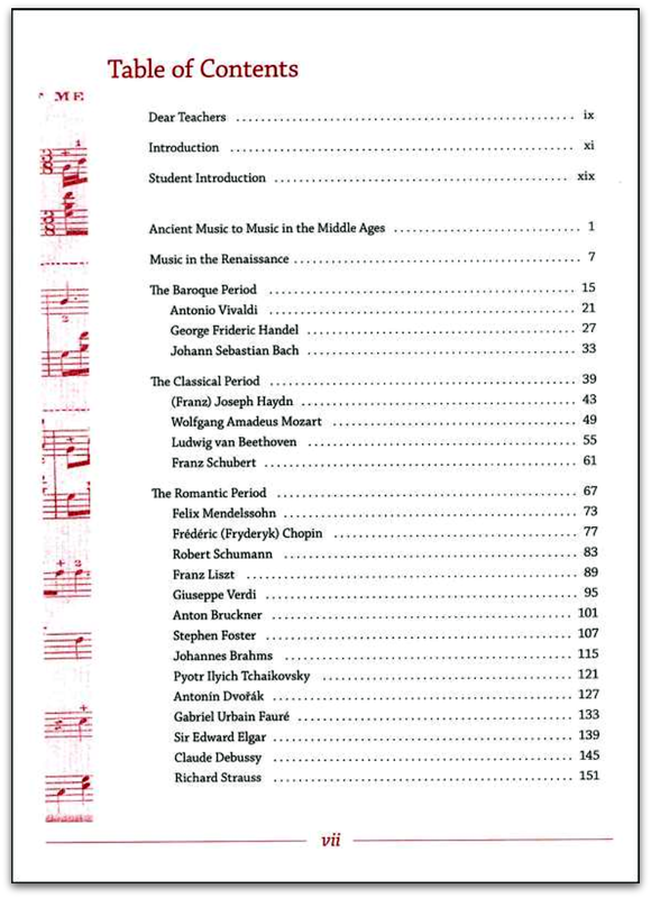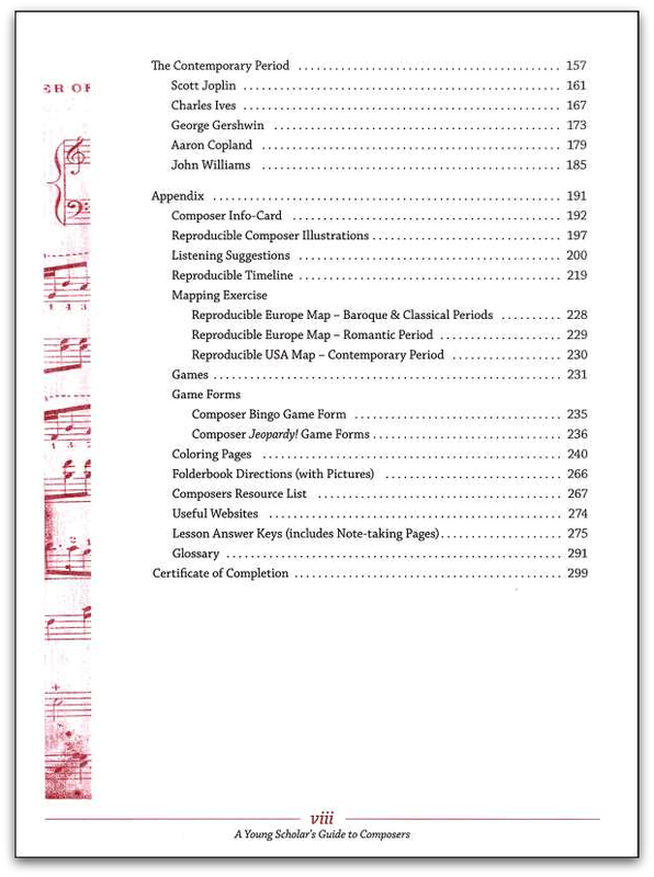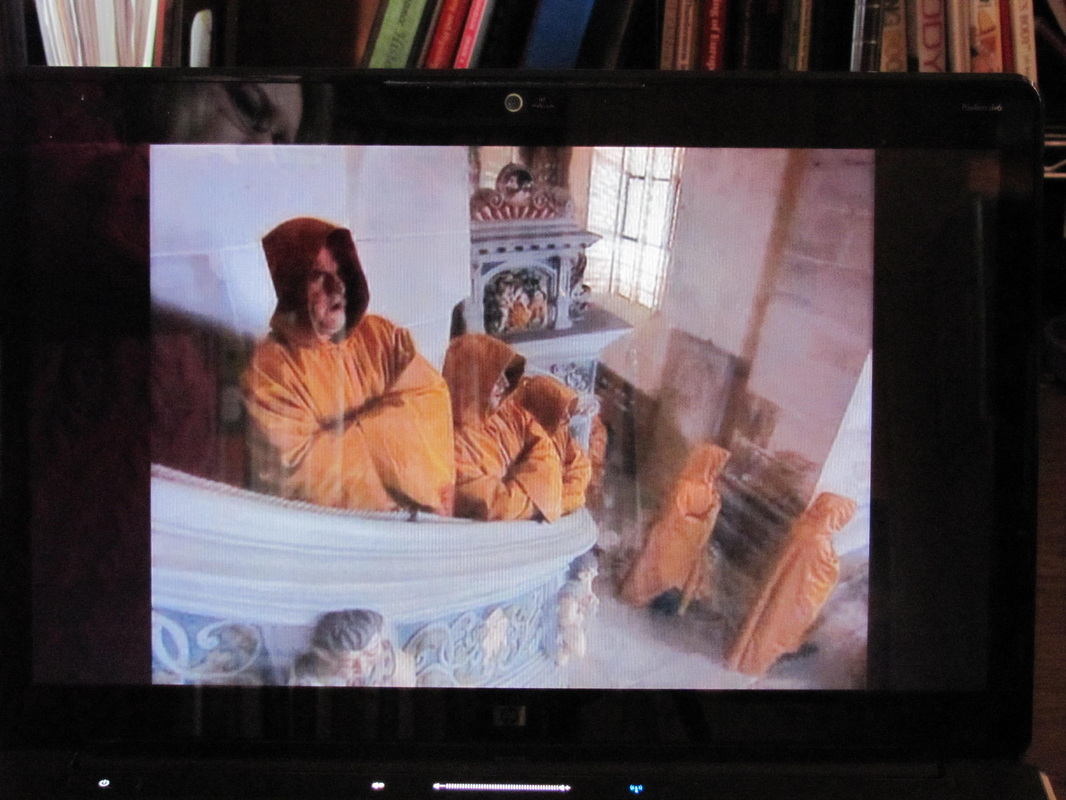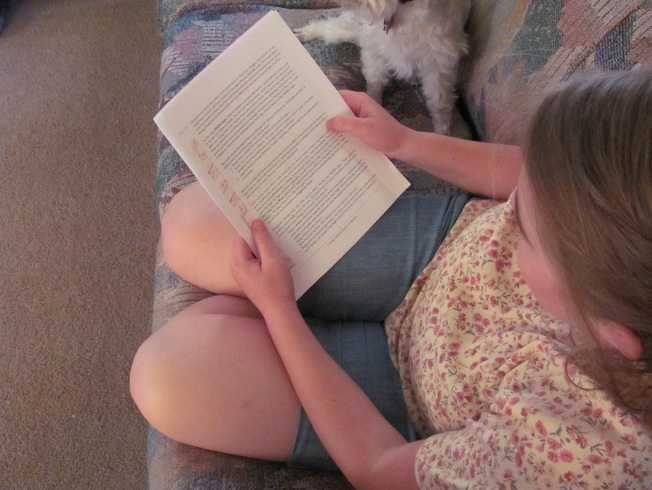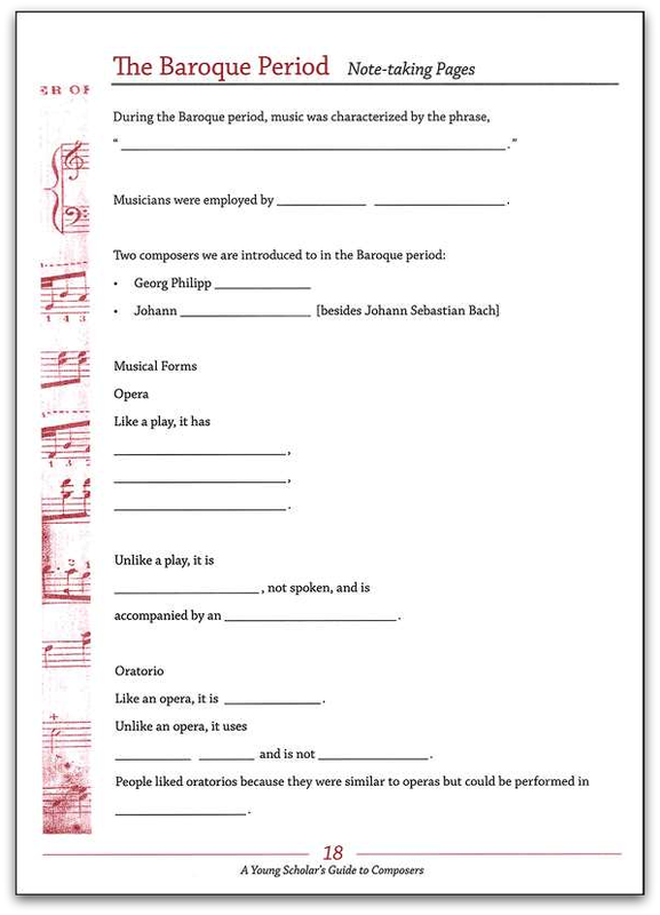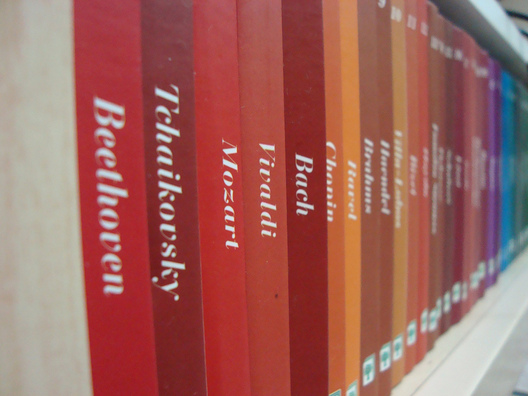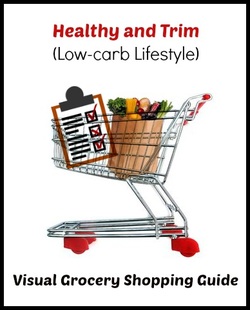|
My daughter's violin instructor mentioned about a year ago that she'd like us to begin researching the composers and understanding more about them and the eras in which they lived. I didn't really have anything at home to use for that, but I did remember that Bright Ideas Press had published a book with that in mind: A Young Scholar's Guide to Composers. We were blessed last month to be able to receive a copy of this book from Timberdoodle in order to use it and review it. We were excited to receive this in the mail! The timing was perfect...although we should have probably been using this a year ago. Oops. Please don't tell our violin instructor, okay? Deal? Deal. The first thing I noticed, after reading through the Table of Contents, is that this book was appropriately placed into chronological order. That's just the way my brain prefers to learn, so this is a good thing. The second thing I noticed was that in the Introduction, it gave a simple outline of how each week's lessons would flow. Their goal was to have this material be presented in a simple way. That sounded great to me! We worked through several weeks of lessons. I'll be the first to say that they were definitely simple to work through! I didn't need to rush to the library to check out additional books; I didn't need to buy anything to accompany this curriculum. I didn't need to do any further lesson planning. Wow! For the first two sections of this book ("Ancient Music to Music in the Middle Ages"; and "Music in the Renaissance"), we approached this differently than the main lessons. We sat right by the laptop. Each time a new composer or song was mentioned, we quickly found a sample of it on YouTube and listened to the first 20-30 seconds of the song. I felt this was important to do, because much of that music is not familiar to many westerners' ears, including me and my children. This stretched out the lessons over a couple of days' time (probably 60 minutes each day), but it was worth it. Slowly but surely, the music began to have more of a "western hemisphere" feel to it. We could see the changes that were being made over hundreds of years' time. If you're not comfortable using YouTube in your home, it is possible to place the YouTube settings to "safe search". You can also place all comments on "safe mode" so that you can view videos and not have to worry so much about viewing inappropriate videos or comments. The nice thing was that A Young Scholar's Guide to Composers explained all about why the changes were happening. It was actually very interesting! The girls went from covering their ears to listening with a grimace to listening with interest. Of course, that took several hundred years to accomplish. Well, at least, in the timeline! Finally, we were ready to start the first main lesson. So...on Day 1 of each new lesson, we first sat down with the laptop and listened, via YouTube, to the music selections recommended for the lesson. It was pretty neat to listen to people performing these selections in medieval and Renaissance churches and locations throughout Europe! Then, we sat down on the couch together and read through the lesson. That took about 15 minutes or so. Sometimes, the girls would have questions, or I'd want to interject some explanation or extra information, so I know we stretched a few of the lessons out longer. While I was reading with them, the girls filled out the high quality note-taking pages provided by the curriculum. While taking notes isn't one of my daughters' favorite methods of learning, she admitted that she was glad that the note-taking pages were provided for her use. She said that it made it easier to stay focused as I read with the girls. Here's a sample of the note-taking pages: On the second day, we listened to the music selections again for that particular lesson, and could do the "hands-on" work to help us learn: 1. Fill out an informational card about the composer 2. Color in a section of the timeline to place composers in the correct era 3. Use provided maps to match composers to their place of birth and work. Easy, peasy! On the third day, we listened to the music selections again and tried to memorize the names of the composer and the songs. If we chose to do additional work and learning about a composer, we could have chosen to make mini-books for a lapbook/folderbook, read a biography about the composer (from the library or separate book purchase), and played a composer review game together. Because this autumn's curriculum list is quite full, we chose not to do those additional activities, but we hope to dive in deeper in the future. Those hands-on projects make learning fun! After learning about the composer for the week, review questions were provided to see what we remembered. This was helpful! While we haven't been able to work through the entire book yet, we have enjoyed A Young Scholar's Guide to the Composers. I like the way that just about everything is contained within the book itself. No need for me to run out to the library or bookstore or to order anything online. Using YouTube videos for the music selections was SO helpful! Everything I saw throughout this curriculum, from the book itself to the maps, timelines, and drawings of characters, was very professional in layout and quality. The only thing I kept hoping to find in the curriculum were pre-printed mini-books for the suggested lapbooking/folderbooking. While I did read some directions in this book about how to make basic mini-books, I hoped that the mini-books would have been printed already so that we could have colored, illustrated, and written on them for our use. For families who are very comfortable with the thought of lapbooking, this won't be a hindrance, but for families who are new to lapbooking or whose time is very stretched, it would be helpful to be able to print out or photocopy the mini-books and then begin using them right away. A Young Scholar's Guide to Composers comes in both a paperback format and on CD. For our family, I'd prefer to have the paperback format and then have a CD that contained just the printables for the curriculum. It would be a bit on the expensive side of things for me to buy both the full curriculum on CD and in paperback form, but that is a possibility. Anyway, we're excited to continue using A Young Scholar's Guide to Composers over the next couple of years, as we approach various composers in our chronological history studies. You may view samples of this curriculum here, at the Bright Ideas Press website. A Young Scholar's Guide to Composers is available for purchase at Timberdoodle, for those who want to increase their knowledge and understanding of music history and famous composers. Timberdoodle also has other music supplies and materials for educating our children. I'm looking forward to checking that out, too! Disclosure: As a member of Timberdoodle's Blogger Review Team, I received a free copy of A Young Scholar's Guide to Composers in exchange for a frank and unbiased review.
179 Comments
2/2/2022 12:13:08 am
Very much appreciated. Thank you for this excellent article. Keep posting!
Reply
10/18/2022 11:07:15 pm
Nice article! Thanks for sharing this informative post. Keep posting!
Reply
11/13/2022 07:36:02 pm
Very informative. Thanks for sharing your article. Looking forward to your latest blog.
Reply
12/28/2022 08:29:20 pm
Excellent article! Your post is essential today. Thanks for sharing, by the way.
Reply
1/5/2023 03:50:24 am
Very informative article! Thank you for sharing.
Reply
1/5/2023 04:28:46 am
Nice post. I learn something totally new and challenging about your websites. Keep posting!
Reply
10/27/2023 08:40:31 pm
Challenge accepted? Prove your skills here! http://luckycola.io/
Reply
12/14/2023 02:52:06 am
Book sexy call girls from the best and reliable Delhi Escorts Service. Our professional call girl services in Delhi. Call 9899869190 now!! Visit here for more information:-https://delhicallgirlservice.in/
Reply
1/25/2024 06:41:51 am
thank you for the better understanding vlog you made.. it will make a guide for me to make may own.
Reply
2/9/2024 10:28:44 pm
I've recently completed reading your blog entry. Your information was truly captivating! It deeply connected with me due to my own personal experience. The way you wrote is incredibly captivating and resonating, and I gained valuable insights from your viewpoint. I appreciate you sharing your thoughts!
Reply
2/12/2024 07:50:22 pm
I found the blog to be particularly insightful, as it provided me with a deeper understanding. This helped me to gain a greater appreciation for the subject matter, and I felt more confident in my abilities after reading it. Additionally, it opened my eyes to new perspectives and ways of thinking, which I found to be invaluable.
Reply
First and foremost, your positivity is infectious! In a world where negativity often dominates, stumbling upon a blog like yours is like discovering a hidden gem. Your ability to find the silver lining in every situation is truly admirable and serves as a beacon of hope for your readers.
Reply
4/16/2024 03:51:11 am
It's a commendable article to read. Thanks and inviting you to kindly try to visit my link to Play and win cash and exciting prizes by visiting https://www.7xm44.app/register?affiliateCode=vsssr
Reply
4/18/2024 01:44:02 am
Great! and awesome. Thank you for sharing this helpful content.
Reply
5/6/2024 06:26:15 am
Thank you! This is helpful information! It's quite an interesting topic. Waiting for your next excellent update.
Reply
5/6/2024 09:04:59 pm
Revive your locks with Purobios Sulphate Free Keratin Rebuild Hair Mask. 500ml size available. Buy online at COSWORLD. Hair mask & colour category.
Reply
6/5/2024 08:01:37 am
Thanks for sharing this useful information! Hope that you will continue with the kind of stuff you are doing.
Reply
6/14/2024 06:45:24 am
What a nice and very helpful article! Thank you for sharing.
Reply
7/2/2024 10:52:44 pm
<a href="https://paripesaapp.online/">paripesaapp</a> a cutting-edge mobile application created for sports enthusiasts and bettors, providing a smooth and interactive platform to engage with live sports events and place bets effortlessly.
Reply
7/3/2024 04:09:49 am
Thanks for sharing this useful information! Hope that you will continue with the kind of stuff you are doing.
Reply
7/3/2024 05:21:30 am
Great Article! Thank you for sharing this is very informative post, and looking forward to the latest one.
Reply
7/6/2024 12:28:03 am
top 10 lottery sites in india opens up a world of excitement and opportunities for lottery enthusiasts. These platforms are renowned for their reliability, diverse lottery offerings, and user-friendly interfaces
Reply
7/8/2024 02:34:36 am
my 11 circle is a dynamic fantasy sports platform that allows users to create their own virtual teams and compete in various sports, including cricket and football.
Reply
7/9/2024 06:04:40 am
my11circle sports is a leading fantasy sports platform that gives enthusiasts the chance to create virtual teams and compete in various sports.
Reply
7/12/2024 08:00:22 pm
The DuckDuckGo Search Engine does their best to make sure these ads are useful to you. When a company pays DuckDuckGo to display their link, they only show up if they match your search and browser history. The Company also excludes known ad-targets, like porn or gambling sites and violent or extreme websites.
Reply
7/17/2024 06:27:35 pm
Great article! I've recently come across MEGASWERTE VIP offers some fantastic features that I think everyone should check out!
Reply
7/17/2024 11:19:25 pm
Amazing article, Thanks for this wonderful information.
Reply
Leave a Reply. |
Hi! I'm Julieanne!
|
